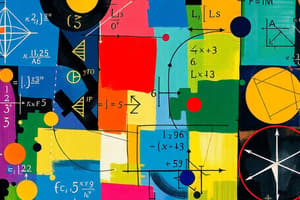Podcast
Questions and Answers
What is the purpose of trigonometry?
What is the purpose of trigonometry?
- To study the properties of polygons
- To calculate the area of a circle
- To determine relationships between sides and angles of triangles (correct)
- To solve algebraic equations
Which of the following is NOT one of the six basic trigonometric functions?
Which of the following is NOT one of the six basic trigonometric functions?
- Sine (sin)
- Cotangent (ctn)
- Cosecant (csc)
- Radial (rad) (correct)
What is the purpose of the denominator in a fraction?
What is the purpose of the denominator in a fraction?
- To convert the fraction to a decimal
- To simplify the fraction
- To indicate the part
- To represent the whole (correct)
How can fractions be simplified?
How can fractions be simplified?
In trigonometry, where can the six basic trigonometric functions be used?
In trigonometry, where can the six basic trigonometric functions be used?
To add or subtract fractions, what is required?
To add or subtract fractions, what is required?
How are equivalent fractions defined?
How are equivalent fractions defined?
What is the process to convert an improper fraction to a mixed number?
What is the process to convert an improper fraction to a mixed number?
To multiply fractions, what part of the fractions is multiplied separately?
To multiply fractions, what part of the fractions is multiplied separately?
How can one divide one fraction by another?
How can one divide one fraction by another?
Study Notes
Math Topics: Trigonometry and Fractions
Trigonometry
Trigonometry is a branch of mathematics dealing with the relationships between sides and angles of triangles. Specifically, it provides methods for calculating unknown sides or angles of right triangles given the lengths of the other two sides or one angle. There are six basic trigonometric functions: sine (sin), cosine (cos), tangent (tan), cosecant (csc), secant (sec), and cotangent (ctn). These functions can also be used for any triangle, not just right ones. Some common uses of trigonometry include calculating distances, heights, and angles, determining the size of right triangular components such as the height of a tree based on the angle of its shadow, and predicting the behavior of waves like sound and light.
Fractions
Fractions are a way of representing parts of a whole. They consist of a numerator (the part) and a denominator (the whole). The denominator can't be zero, and the numerator must be smaller than the denominator. Fractions can be simplified by dividing both the numerator and the denominator by the denominator's greatest common divisor. If the numerator is a multiple of the denominator, the fraction is already in its simplest form. Fractions are used in mathematics and everyday life, such as when measuring ingredients in a recipe, calculating proportions, or solving word problems.
Simplifying Fractions
To simplify a fraction, you can follow these steps:
- Factor the numerator and denominator completely.
- Divide both the numerator and the denominator by the greatest common divisor.
- If the numerator is a multiple of the denominator, the fraction is already in its simplest form.
Adding and Subtracting Fractions
To add or subtract fractions, you need to have the same denominator. If the denominators are different, you need to find the least common multiple (LCM) of the denominators and convert each fraction to an equivalent fraction with the LCM as the denominator. Then, add or subtract the numerators.
Multiplying and Dividing Fractions
To multiply fractions, you multiply the numerators and the denominators separately. To divide one fraction by another, you invert the second fraction (change the numerator and denominator) and multiply.
Improper Fractions
An improper fraction is the sum of a fraction and a whole number. It can be converted to a mixed number by dividing the numerator by the denominator and expressing the quotient as the whole number part and the remainder as the numerator. The denominator remains the same.
Equivalent Fractions
Equivalent fractions are fractions that have the same value. They have the same numerator and different denominators. Equivalent fractions are obtained by multiplying or dividing the numerator and the denominator by the same non-zero number.
Fraction Addition and Subtraction Worksheets
Fraction addition and subtraction worksheets can be found online, allowing students to practice adding and subtracting fractions. These worksheets can help reinforce the concepts of like denominators, the least common multiple, and the properties of fractions.
Studying That Suits You
Use AI to generate personalized quizzes and flashcards to suit your learning preferences.
Description
Explore fundamental concepts in trigonometry such as sine, cosine, tangent, and in fractions including simplifying, adding, subtracting, multiplying, dividing, improper fractions, and equivalent fractions. Learn how to apply these concepts in real-life scenarios and mathematical problems.




